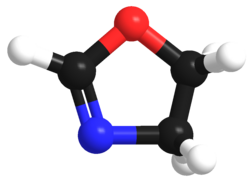Loading AI tools
Chemical compound From Wikipedia, the free encyclopedia
Oxazoline is a five-membered heterocyclic organic compound with the formula C3H5NO. It is the parent of a family of compounds called oxazolines (emphasis on plural), which contain non-hydrogenic substituents on carbon and/or nitrogen. Oxazolines are the unsaturated analogues of oxazolidines, and they are isomeric with isoxazolines, where the N and O are directly bonded. Two isomers of oxazoline are known, depending on the location of the double bond.
 | |
 | |
| Names | |
|---|---|
| Preferred IUPAC name
4,5-Dihydro-1,3-oxazole | |
| Other names
Δ2-oxazoline | |
| Identifiers | |
| |
3D model (JSmol) |
|
| ChemSpider | |
| ECHA InfoCard | 100.007.274 |
PubChem CID |
|
| UNII |
|
CompTox Dashboard (EPA) |
|
| |
| |
| Properties | |
| C3H5NO | |
| Molar mass | 71.079 g·mol−1 |
| Density | 1.075unit?[1] |
| Boiling point | 98 °C (208 °F; 371 K)[1] |
Except where otherwise noted, data are given for materials in their standard state (at 25 °C [77 °F], 100 kPa).
| |
Oxazoline itself has no applications however oxazolines have been widely investigated for potential applications. These applications include use as ligands in asymmetric catalysis, as protecting groups for carboxylic acids and increasingly as monomers for the production of polymers.
 |
Three structural isomers of oxazoline are possible depending on the location of the double bond, however only 2‑oxazolines are common. 4‑Oxazolines are formed as intermediates during the production of certain azomethine ylides[2] but are otherwise rare. 3‑Oxazolines are even less common but have been synthesised photochemically[3] and by the ring opening of azirines.[4] These three forms do not readily interconvert and hence are not tautomers.
A fourth isomer exists in which the O and N atoms are adjacent, this is known as isoxazoline. |
The synthesis of 2-oxazoline rings is well established and in general proceeds via the cyclisation of a 2-amino alcohol (typically obtained by the reduction of an amino acid) with a suitable functional group.[5][6][7] The overall mechanism is usually subject to Baldwin's rules.
The usual route to oxazolines entails reaction of acyl chlorides with 2-amino alcohols. Thionyl chloride is commonly used to generate the acid chloride in situ, care being taken to maintain anhydrous conditions, as oxazolines can be ring-opened by chloride if the imine becomes protonated.[8] The reaction is typically performed at room temperature. If reagents milder than SOCl2 are required, oxalyl chloride can be used.[9] Aminomethyl propanol is a popular precursor amino alcohol.[10][11]
Modification of the Appel reaction allows for the synthesis of oxazoline rings.[12] This method proceeds under relatively mild conditions, however, owing to the large amounts of triphenylphosphine oxide produced, is not ideal for large-scale reactions. The use of this method is becoming less common, due to carbon tetrachloride being restricted under the Montreal protocol.
The cyclisation of an amino alcohol and an aldehyde produces an intermediate oxazolidine which can be converted to an oxazoline by treatment with a halogen-based oxidising agent (e.g. NBS,[13] or iodine[14]); this potentially proceeds via an imidoyl halide. The method has been shown to be effective for a wide range of aromatic and aliphatic aldehydes however electron rich aromatic R groups, such as phenols, are unsuitable as they preferentially undergo rapid electrophilic aromatic halogenation with the oxidising agent.
The use of catalytic amounts of ZnCl2 to generate oxazolines from nitriles was first described by Witte and Seeliger,[15][16] and further developed by Bolm et al.[17] The reaction requires high temperatures to succeed and is typically performed in refluxing chlorobenzene under anhydrous conditions. A precise reaction mechanism has never been proposed, although it is likely similar to the Pinner reaction; preceding via an intermediate amidine.[18][19] Limited research has been done into identifying alternative solvents or catalysts for the reaction.[20][21]
Ligands containing a chiral 2-oxazoline ring are used in asymmetric catalysis due to their facile synthesis, wide range of forms and effectiveness for many types of catalytic transformation.[22][23]
2-Substituted oxazolines possess a moderately hard N-donor. Chirality is easily incorporated by using 2-amino alcohols prepared by the reduction of amino acids; which are both optically pure and inexpensive. As the stereocentre in such oxazolines is adjacent to the coordinating N-atom, it can influence the selectivity of processes occurring at the metal centre. The ring is thermally stable[24] and resistant to nucleophiles, bases, radicals, and weak acids[25] as well as being fairly resistant to hydrolysis and oxidation;[5] thus it can be expected to remain stable in a wide range of reaction conditions.
Major classes of oxazoline based ligand include:
Notable specialist oxazoline ligands include:
Some 2-oxazolines, such as 2-ethyl-2-oxazoline, undergo living cationic ring-opening polymerisation to form poly(2-oxazoline)s.[26] These are polyamides and can be regarded as analogues of peptides; they have numerous potential applications[27] and have received particular attention for their biomedical uses.[28][29]
The dimethyloxazoline (DMOX) derivatives of fatty acids are amenable to analysis by gas chromatography.
Structural analogues
Other pages
Seamless Wikipedia browsing. On steroids.
Every time you click a link to Wikipedia, Wiktionary or Wikiquote in your browser's search results, it will show the modern Wikiwand interface.
Wikiwand extension is a five stars, simple, with minimum permission required to keep your browsing private, safe and transparent.